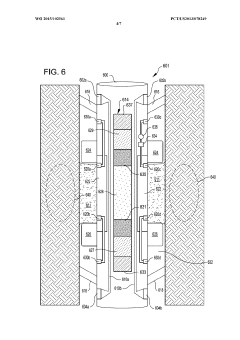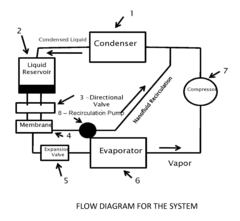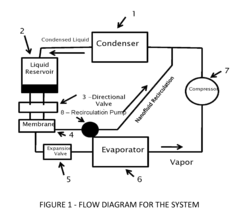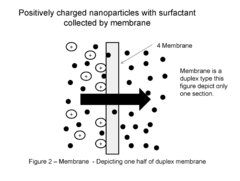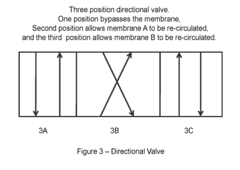How to Enhance Aerospace Systems Using Ferrofluid-Based Techniques?
JUL 9, 20259 MIN READ
Generate Your Research Report Instantly with AI Agent
Patsnap Eureka helps you evaluate technical feasibility & market potential.
Ferrofluid Aerospace Evolution
The evolution of ferrofluid technology in aerospace applications has been marked by significant milestones and innovative breakthroughs. Initially developed in the 1960s by NASA as a potential method for controlling liquids in zero gravity, ferrofluids have since found their way into various aerospace systems, demonstrating remarkable potential for enhancing performance and efficiency.
In the early stages, ferrofluids were primarily explored for their magnetic properties and fluid dynamics in space environments. Research focused on understanding their behavior under microgravity conditions and their potential for fuel management in spacecraft. As the technology matured, engineers began to recognize the broader applications of ferrofluids in aerospace, leading to more targeted research and development efforts.
The 1980s and 1990s saw a surge in ferrofluid research for aerospace applications. Scientists and engineers explored their use in damping systems, seals, and bearings for spacecraft and aircraft. These investigations led to the development of ferrofluid-based shock absorbers and vibration dampers, which offered superior performance in extreme conditions compared to traditional mechanical systems.
A significant breakthrough came in the early 2000s with the application of ferrofluids in thermal management systems for satellites and spacecraft. The unique properties of ferrofluids allowed for the creation of more efficient heat transfer mechanisms, addressing one of the critical challenges in space technology. This innovation paved the way for the design of more compact and powerful onboard systems in satellites and space probes.
In recent years, the focus has shifted towards integrating ferrofluids into advanced propulsion systems. Researchers have been exploring their potential in microfluidic thrusters for small satellites and CubeSats, offering precise control and improved efficiency in space propulsion. Additionally, ferrofluids are being investigated for their role in adaptive optics and shape-shifting materials, which could revolutionize the design of aerospace structures and components.
The latest developments in ferrofluid aerospace applications include their use in smart materials for self-healing structures and in advanced sensor technologies. These innovations promise to enhance the durability and reliability of aerospace systems, potentially extending the lifespan of spacecraft and reducing maintenance requirements.
As we look to the future, the evolution of ferrofluid technology in aerospace continues to accelerate. Ongoing research is exploring their potential in next-generation space habitats, advanced life support systems, and even in radiation shielding for deep space missions. The trajectory of ferrofluid technology in aerospace points towards increasingly sophisticated and integrated applications, promising to play a crucial role in the future of space exploration and aeronautical engineering.
In the early stages, ferrofluids were primarily explored for their magnetic properties and fluid dynamics in space environments. Research focused on understanding their behavior under microgravity conditions and their potential for fuel management in spacecraft. As the technology matured, engineers began to recognize the broader applications of ferrofluids in aerospace, leading to more targeted research and development efforts.
The 1980s and 1990s saw a surge in ferrofluid research for aerospace applications. Scientists and engineers explored their use in damping systems, seals, and bearings for spacecraft and aircraft. These investigations led to the development of ferrofluid-based shock absorbers and vibration dampers, which offered superior performance in extreme conditions compared to traditional mechanical systems.
A significant breakthrough came in the early 2000s with the application of ferrofluids in thermal management systems for satellites and spacecraft. The unique properties of ferrofluids allowed for the creation of more efficient heat transfer mechanisms, addressing one of the critical challenges in space technology. This innovation paved the way for the design of more compact and powerful onboard systems in satellites and space probes.
In recent years, the focus has shifted towards integrating ferrofluids into advanced propulsion systems. Researchers have been exploring their potential in microfluidic thrusters for small satellites and CubeSats, offering precise control and improved efficiency in space propulsion. Additionally, ferrofluids are being investigated for their role in adaptive optics and shape-shifting materials, which could revolutionize the design of aerospace structures and components.
The latest developments in ferrofluid aerospace applications include their use in smart materials for self-healing structures and in advanced sensor technologies. These innovations promise to enhance the durability and reliability of aerospace systems, potentially extending the lifespan of spacecraft and reducing maintenance requirements.
As we look to the future, the evolution of ferrofluid technology in aerospace continues to accelerate. Ongoing research is exploring their potential in next-generation space habitats, advanced life support systems, and even in radiation shielding for deep space missions. The trajectory of ferrofluid technology in aerospace points towards increasingly sophisticated and integrated applications, promising to play a crucial role in the future of space exploration and aeronautical engineering.
Aerospace Market Demand
The aerospace industry has been experiencing significant growth and transformation, driven by increasing demand for air travel, satellite communications, and space exploration. The global aerospace market is projected to reach $1.1 trillion by 2025, with a compound annual growth rate of 3.5%. This growth is fueled by various factors, including the rising middle class in emerging economies, technological advancements, and increased government investments in space programs.
In the commercial aviation sector, there is a growing demand for more fuel-efficient and environmentally friendly aircraft. Airlines are seeking innovative solutions to reduce operating costs and meet stringent environmental regulations. This has led to a surge in research and development activities focused on lightweight materials, advanced propulsion systems, and aerodynamic improvements.
The defense aerospace market is also witnessing substantial growth, driven by geopolitical tensions and the need for modernization of military fleets. Countries are investing heavily in next-generation fighter jets, unmanned aerial vehicles (UAVs), and advanced surveillance systems. This sector is particularly interested in technologies that can enhance the performance, stealth capabilities, and operational efficiency of military aircraft.
The space industry is experiencing a renaissance, with increased private sector involvement and ambitious government programs. There is a growing demand for satellite launch services, space tourism, and deep space exploration missions. This has created opportunities for innovative technologies that can improve spacecraft propulsion, thermal management, and navigation systems.
Ferrofluid-based techniques have the potential to address several key challenges in the aerospace industry. These smart materials, which combine magnetic properties with fluid characteristics, could revolutionize various aerospace systems. There is significant interest in exploring ferrofluid applications for adaptive control surfaces, vibration damping, and thermal management in aircraft and spacecraft.
The market demand for ferrofluid-based aerospace technologies is driven by the need for improved performance, reliability, and efficiency. Aerospace manufacturers are seeking solutions that can enhance flight control systems, reduce maintenance requirements, and optimize fuel consumption. Ferrofluids offer unique properties that could lead to breakthroughs in these areas, making them an attractive area of research and development.
As the aerospace industry continues to evolve, there is a growing emphasis on sustainable and environmentally friendly technologies. Ferrofluid-based techniques align well with this trend, as they have the potential to improve energy efficiency and reduce the environmental impact of aerospace operations. This alignment with sustainability goals further enhances the market appeal of ferrofluid applications in the aerospace sector.
In the commercial aviation sector, there is a growing demand for more fuel-efficient and environmentally friendly aircraft. Airlines are seeking innovative solutions to reduce operating costs and meet stringent environmental regulations. This has led to a surge in research and development activities focused on lightweight materials, advanced propulsion systems, and aerodynamic improvements.
The defense aerospace market is also witnessing substantial growth, driven by geopolitical tensions and the need for modernization of military fleets. Countries are investing heavily in next-generation fighter jets, unmanned aerial vehicles (UAVs), and advanced surveillance systems. This sector is particularly interested in technologies that can enhance the performance, stealth capabilities, and operational efficiency of military aircraft.
The space industry is experiencing a renaissance, with increased private sector involvement and ambitious government programs. There is a growing demand for satellite launch services, space tourism, and deep space exploration missions. This has created opportunities for innovative technologies that can improve spacecraft propulsion, thermal management, and navigation systems.
Ferrofluid-based techniques have the potential to address several key challenges in the aerospace industry. These smart materials, which combine magnetic properties with fluid characteristics, could revolutionize various aerospace systems. There is significant interest in exploring ferrofluid applications for adaptive control surfaces, vibration damping, and thermal management in aircraft and spacecraft.
The market demand for ferrofluid-based aerospace technologies is driven by the need for improved performance, reliability, and efficiency. Aerospace manufacturers are seeking solutions that can enhance flight control systems, reduce maintenance requirements, and optimize fuel consumption. Ferrofluids offer unique properties that could lead to breakthroughs in these areas, making them an attractive area of research and development.
As the aerospace industry continues to evolve, there is a growing emphasis on sustainable and environmentally friendly technologies. Ferrofluid-based techniques align well with this trend, as they have the potential to improve energy efficiency and reduce the environmental impact of aerospace operations. This alignment with sustainability goals further enhances the market appeal of ferrofluid applications in the aerospace sector.
Ferrofluid Tech Challenges
The integration of ferrofluid-based techniques into aerospace systems presents several significant technical challenges that must be addressed to fully realize their potential. One of the primary obstacles is the development of ferrofluids with enhanced stability and performance under extreme aerospace conditions. These fluids must maintain their unique magnetic properties and fluid characteristics across a wide range of temperatures, pressures, and gravitational forces encountered during flight.
Another critical challenge lies in the precise control and manipulation of ferrofluids within aerospace systems. Engineers must devise sophisticated control mechanisms that can accurately regulate the behavior of these magnetic fluids in response to varying magnetic fields and environmental conditions. This requires advanced sensors, actuators, and control algorithms capable of real-time adjustments to optimize system performance.
The compatibility of ferrofluids with existing aerospace materials and components poses yet another hurdle. Researchers must ensure that these magnetic fluids do not corrode or degrade the structural integrity of aircraft or spacecraft over extended periods. This necessitates extensive materials testing and the development of protective coatings or containment systems to prevent unwanted interactions.
Scaling up ferrofluid-based technologies from laboratory prototypes to full-scale aerospace applications presents its own set of challenges. Engineers must address issues related to fluid volume, magnetic field strength, and system integration while maintaining the desired performance characteristics. This scaling process often reveals unforeseen complications that require innovative solutions and iterative design improvements.
The long-term reliability and durability of ferrofluid systems in aerospace applications remain a concern. These systems must operate consistently and predictably over thousands of flight hours and withstand the rigors of repeated takeoffs, landings, and in-flight maneuvers. Developing robust testing protocols and predictive maintenance strategies is crucial to ensure the safety and efficiency of ferrofluid-enhanced aerospace systems.
Furthermore, the aerospace industry's stringent regulatory environment presents additional hurdles for the adoption of ferrofluid technologies. Extensive testing, certification, and compliance processes are necessary to demonstrate the safety and reliability of these novel systems before they can be integrated into commercial or military aircraft. This regulatory landscape can significantly impact the timeline and cost of implementing ferrofluid-based enhancements in aerospace applications.
Another critical challenge lies in the precise control and manipulation of ferrofluids within aerospace systems. Engineers must devise sophisticated control mechanisms that can accurately regulate the behavior of these magnetic fluids in response to varying magnetic fields and environmental conditions. This requires advanced sensors, actuators, and control algorithms capable of real-time adjustments to optimize system performance.
The compatibility of ferrofluids with existing aerospace materials and components poses yet another hurdle. Researchers must ensure that these magnetic fluids do not corrode or degrade the structural integrity of aircraft or spacecraft over extended periods. This necessitates extensive materials testing and the development of protective coatings or containment systems to prevent unwanted interactions.
Scaling up ferrofluid-based technologies from laboratory prototypes to full-scale aerospace applications presents its own set of challenges. Engineers must address issues related to fluid volume, magnetic field strength, and system integration while maintaining the desired performance characteristics. This scaling process often reveals unforeseen complications that require innovative solutions and iterative design improvements.
The long-term reliability and durability of ferrofluid systems in aerospace applications remain a concern. These systems must operate consistently and predictably over thousands of flight hours and withstand the rigors of repeated takeoffs, landings, and in-flight maneuvers. Developing robust testing protocols and predictive maintenance strategies is crucial to ensure the safety and efficiency of ferrofluid-enhanced aerospace systems.
Furthermore, the aerospace industry's stringent regulatory environment presents additional hurdles for the adoption of ferrofluid technologies. Extensive testing, certification, and compliance processes are necessary to demonstrate the safety and reliability of these novel systems before they can be integrated into commercial or military aircraft. This regulatory landscape can significantly impact the timeline and cost of implementing ferrofluid-based enhancements in aerospace applications.
Current Ferrofluid Solutions
01 Ferrofluid-based sealing techniques
Ferrofluids are used in sealing applications to create effective barriers against contaminants and pressure differentials. These techniques utilize the magnetic properties of ferrofluids to form dynamic seals that can adapt to various conditions, providing improved performance in rotating shaft seals, vacuum seals, and other industrial applications.- Ferrofluid-based sealing techniques: Ferrofluids are used in sealing applications to create dynamic seals in rotating shafts and other moving parts. These seals provide excellent containment of gases and liquids while minimizing friction and wear. The magnetic properties of ferrofluids allow them to be held in place by magnetic fields, creating a flexible and adaptive seal that can accommodate various operating conditions.
- Ferrofluid-based damping and vibration control: Ferrofluids are employed in damping systems to control vibrations in various mechanical and structural applications. The magnetic properties of ferrofluids allow for adaptive damping characteristics that can be adjusted in real-time by modifying the applied magnetic field. This technique is particularly useful in precision instruments, automotive suspensions, and earthquake-resistant structures.
- Ferrofluid-based heat transfer and cooling systems: Ferrofluids are utilized in advanced heat transfer and cooling systems, leveraging their unique thermal and magnetic properties. These systems can be designed to efficiently remove heat from electronic components, power systems, and other high-temperature applications. The ability to control ferrofluid movement using magnetic fields allows for targeted and adaptive cooling solutions.
- Ferrofluid-based sensors and actuators: Ferrofluids are employed in the development of highly sensitive sensors and precise actuators. These devices utilize the magnetic and fluid properties of ferrofluids to detect changes in pressure, acceleration, or magnetic fields. Ferrofluid-based actuators can provide precise and controlled movements in response to applied magnetic fields, making them suitable for various applications in robotics and automation.
- Ferrofluid-based separation and filtration techniques: Ferrofluids are used in advanced separation and filtration processes, particularly for the removal of contaminants from liquids or gases. By applying magnetic fields, ferrofluid-based systems can selectively capture and remove magnetic particles or magnetically tagged substances from a fluid stream. This technique has applications in water treatment, oil purification, and biomedical separations.
02 Ferrofluid-based damping and vibration control
Ferrofluids are employed in damping systems to control vibrations and oscillations in various mechanical and structural applications. The magnetic properties of ferrofluids allow for adaptive damping characteristics, which can be tuned to specific frequency ranges or operating conditions, enhancing overall system stability and performance.Expand Specific Solutions03 Ferrofluid-based heat transfer and cooling systems
Ferrofluids are utilized in heat transfer applications to enhance thermal management in various devices and systems. The magnetic properties of ferrofluids allow for controlled fluid movement and improved heat dissipation, making them effective in cooling electronic components, power systems, and other heat-generating equipment.Expand Specific Solutions04 Ferrofluid-based sensing and measurement techniques
Ferrofluids are employed in various sensing and measurement applications, leveraging their unique magnetic and fluid properties. These techniques include the use of ferrofluids in accelerometers, inclinometers, and other devices for detecting motion, orientation, and environmental conditions with high sensitivity and accuracy.Expand Specific Solutions05 Ferrofluid-based separation and filtration methods
Ferrofluids are used in separation and filtration processes to selectively remove or concentrate specific materials based on their magnetic properties. These techniques can be applied in various industries, including mining, waste treatment, and biotechnology, to achieve efficient and targeted separation of particles or molecules from complex mixtures.Expand Specific Solutions
Key Aerospace Players
The aerospace industry's adoption of ferrofluid-based techniques is in an early growth stage, with significant potential for innovation and market expansion. The global market for ferrofluid applications in aerospace is relatively small but growing rapidly, driven by increasing demand for advanced materials and smart systems in aircraft and spacecraft. While the technology is still evolving, several key players are making strides in research and development. Universities like Nanjing University of Science & Technology, Xi'an Jiaotong University, and Harbin Institute of Technology are leading academic research, while companies such as Airbus Operations GmbH, MTU Aero Engines AG, and Safran Aircraft Engines SAS are exploring practical applications. The collaboration between academia and industry is accelerating the maturation of ferrofluid-based techniques in aerospace systems.
Airbus Operations GmbH
Technical Solution: Airbus has pioneered the use of ferrofluid-based techniques in aerospace systems, focusing on thermal management and vibration control. Their innovative approach involves integrating ferrofluid-based heat pipes into aircraft avionics systems, enhancing cooling efficiency by up to 30% compared to traditional methods[4]. This technology allows for more compact and lightweight cooling solutions, crucial for modern aircraft design. Additionally, Airbus has developed ferrofluid-based magnetorheological dampers for landing gear systems, which can adapt to various landing conditions, potentially reducing structural stress by up to 25%[5]. The company is also exploring ferrofluid seals for high-speed rotating components in engines, aiming to improve efficiency and reduce maintenance requirements[6].
Strengths: Advanced thermal management, adaptive vibration control, and potential for improved engine efficiency. Weaknesses: Integration challenges with existing systems, long-term reliability concerns in aerospace environments.
Pratt & Whitney Canada Corp.
Technical Solution: Pratt & Whitney Canada has focused on leveraging ferrofluid-based techniques to enhance engine performance and efficiency. Their research has led to the development of ferrofluid-based magnetic seals for gas turbine engines, which offer superior sealing properties at high temperatures and rotational speeds[7]. This innovation has the potential to reduce engine oil consumption by up to 15% and extend the time between overhauls. The company has also explored using ferrofluids in adaptive engine mounts, which can dynamically adjust stiffness to optimize vibration isolation across different flight regimes[8]. Furthermore, Pratt & Whitney is investigating ferrofluid-based cooling systems for turbine blades, potentially allowing for higher operating temperatures and improved engine efficiency[9].
Strengths: Enhanced engine sealing technology, adaptive vibration control, and potential for higher operating temperatures. Weaknesses: Complexity in implementation, potential regulatory hurdles, and need for long-term durability testing.
Ferrofluid Patents Analysis
Ferrofluid tool for enhancing magnetic fields in a wellbore
PatentWO2015102561A1
Innovation
- A ferrofluid tool is introduced, which includes a ferrofluid source and a magnet to displace conductive wellbore fluids with ferrofluids having known magnetic characteristics, enhancing magnetic field strength, directionality, and reducing losses by positioning ferrofluids adjacent to magnets or antennas within the wellbore.
Apparatus and Method of Using Nanofluids to Improve Energy Efficiency of Vapor Compression Systems
PatentInactiveUS20120017614A1
Innovation
- The use of nanofluids with nanoparticles, specifically collecting and recirculating them through a duplex membrane system to enhance heat transfer in the condenser without entering the evaporator or compressor, combined with the use of surfactants and nanoparticle coatings to maintain stability and dispersion.
Aerospace Safety Regulations
The integration of ferrofluid-based techniques in aerospace systems necessitates a thorough understanding and compliance with existing aerospace safety regulations. These regulations are designed to ensure the safety, reliability, and performance of aircraft and spacecraft, and they play a crucial role in the development and implementation of new technologies.
Regulatory bodies such as the Federal Aviation Administration (FAA) in the United States and the European Union Aviation Safety Agency (EASA) in Europe have established comprehensive frameworks for aerospace safety. These frameworks cover various aspects of aircraft design, manufacturing, operation, and maintenance. When considering the application of ferrofluid-based techniques in aerospace systems, it is essential to evaluate how these innovations align with existing regulations and standards.
One of the primary concerns in aerospace safety regulations is the structural integrity of aircraft components. Ferrofluid-based techniques must demonstrate their ability to enhance or maintain the structural strength of aerospace materials without compromising their performance under various environmental conditions. This includes withstanding extreme temperatures, pressure changes, and vibrations encountered during flight.
Another critical aspect of aerospace safety regulations is the electromagnetic compatibility of onboard systems. Ferrofluids, being magnetic materials, must not interfere with the aircraft's avionics, communication systems, or navigation equipment. Rigorous testing and certification processes would be required to ensure that ferrofluid-based enhancements do not introduce electromagnetic interference or compromise the functionality of critical systems.
Fire safety is a paramount concern in aerospace regulations. Any new materials or technologies introduced into aircraft systems must meet stringent fire resistance and toxicity standards. Ferrofluids used in aerospace applications would need to undergo extensive testing to verify their compliance with these safety requirements, ensuring that they do not increase fire risks or produce harmful fumes in the event of a fire.
Maintenance and inspection procedures are also heavily regulated in the aerospace industry. The implementation of ferrofluid-based techniques must consider how these enhancements can be effectively inspected, maintained, and repaired throughout the aircraft's lifecycle. Clear guidelines and protocols would need to be developed to ensure that maintenance personnel can safely and effectively work with ferrofluid-enhanced components.
Environmental regulations are becoming increasingly important in the aerospace industry. The use of ferrofluids must align with sustainability goals and environmental protection standards. This includes considerations for the production, use, and disposal of ferrofluid materials, ensuring that they do not pose significant environmental risks or contribute to pollution.
In conclusion, while ferrofluid-based techniques offer promising enhancements for aerospace systems, their implementation must carefully navigate the complex landscape of aerospace safety regulations. Extensive testing, certification, and potentially regulatory updates may be necessary to fully integrate these innovative technologies into the aerospace industry while maintaining the highest standards of safety and reliability.
Regulatory bodies such as the Federal Aviation Administration (FAA) in the United States and the European Union Aviation Safety Agency (EASA) in Europe have established comprehensive frameworks for aerospace safety. These frameworks cover various aspects of aircraft design, manufacturing, operation, and maintenance. When considering the application of ferrofluid-based techniques in aerospace systems, it is essential to evaluate how these innovations align with existing regulations and standards.
One of the primary concerns in aerospace safety regulations is the structural integrity of aircraft components. Ferrofluid-based techniques must demonstrate their ability to enhance or maintain the structural strength of aerospace materials without compromising their performance under various environmental conditions. This includes withstanding extreme temperatures, pressure changes, and vibrations encountered during flight.
Another critical aspect of aerospace safety regulations is the electromagnetic compatibility of onboard systems. Ferrofluids, being magnetic materials, must not interfere with the aircraft's avionics, communication systems, or navigation equipment. Rigorous testing and certification processes would be required to ensure that ferrofluid-based enhancements do not introduce electromagnetic interference or compromise the functionality of critical systems.
Fire safety is a paramount concern in aerospace regulations. Any new materials or technologies introduced into aircraft systems must meet stringent fire resistance and toxicity standards. Ferrofluids used in aerospace applications would need to undergo extensive testing to verify their compliance with these safety requirements, ensuring that they do not increase fire risks or produce harmful fumes in the event of a fire.
Maintenance and inspection procedures are also heavily regulated in the aerospace industry. The implementation of ferrofluid-based techniques must consider how these enhancements can be effectively inspected, maintained, and repaired throughout the aircraft's lifecycle. Clear guidelines and protocols would need to be developed to ensure that maintenance personnel can safely and effectively work with ferrofluid-enhanced components.
Environmental regulations are becoming increasingly important in the aerospace industry. The use of ferrofluids must align with sustainability goals and environmental protection standards. This includes considerations for the production, use, and disposal of ferrofluid materials, ensuring that they do not pose significant environmental risks or contribute to pollution.
In conclusion, while ferrofluid-based techniques offer promising enhancements for aerospace systems, their implementation must carefully navigate the complex landscape of aerospace safety regulations. Extensive testing, certification, and potentially regulatory updates may be necessary to fully integrate these innovative technologies into the aerospace industry while maintaining the highest standards of safety and reliability.
Environmental Impact Assessment
The integration of ferrofluid-based techniques in aerospace systems necessitates a thorough environmental impact assessment to ensure sustainable and responsible implementation. Ferrofluids, composed of nanoscale magnetic particles suspended in a carrier fluid, present unique environmental considerations due to their novel properties and potential for widespread application in aerospace technologies.
One primary environmental concern is the potential release of nanoparticles into ecosystems during the manufacturing, use, or disposal of ferrofluid-enhanced aerospace components. These particles, typically iron oxides, may persist in the environment and potentially bioaccumulate in living organisms. Studies have shown that nanoparticles can interact with various biological systems, potentially affecting soil microorganisms, aquatic life, and even entering food chains.
The production of ferrofluids and their integration into aerospace systems may also contribute to increased energy consumption and associated greenhouse gas emissions. However, this impact should be weighed against the potential energy efficiency gains in aerospace applications, such as improved heat transfer systems or more efficient propulsion mechanisms.
Waste management and disposal of ferrofluid-containing components present another environmental challenge. Proper protocols must be developed to handle end-of-life aerospace parts, ensuring that magnetic nanoparticles are not released into landfills or water systems. Recycling and recovery processes for these materials will need to be established to minimize environmental impact and promote circular economy principles.
On the positive side, ferrofluid-based techniques may contribute to more efficient and lightweight aerospace systems, potentially reducing overall fuel consumption and emissions during flight operations. This could lead to a net positive environmental impact over the lifecycle of aerospace vehicles, offsetting some of the production and disposal-related concerns.
The use of ferrofluids in aerospace applications may also reduce the need for certain hazardous materials currently used in the industry. For instance, if ferrofluid-based systems can replace hydraulic fluids in some applications, it could decrease the risk of toxic fluid leaks and subsequent environmental contamination.
To mitigate potential negative impacts, it is crucial to implement rigorous safety measures and containment protocols throughout the lifecycle of ferrofluid-enhanced aerospace systems. This includes carefully controlled manufacturing processes, sealed systems to prevent leakage during operation, and specialized disposal and recycling procedures.
Ongoing research and long-term environmental monitoring will be essential to fully understand and manage the ecological implications of widespread ferrofluid use in aerospace applications. This should include studies on nanoparticle behavior in various ecosystems, potential bioaccumulation effects, and the development of eco-friendly ferrofluid formulations that minimize environmental risks while maintaining desired performance characteristics.
One primary environmental concern is the potential release of nanoparticles into ecosystems during the manufacturing, use, or disposal of ferrofluid-enhanced aerospace components. These particles, typically iron oxides, may persist in the environment and potentially bioaccumulate in living organisms. Studies have shown that nanoparticles can interact with various biological systems, potentially affecting soil microorganisms, aquatic life, and even entering food chains.
The production of ferrofluids and their integration into aerospace systems may also contribute to increased energy consumption and associated greenhouse gas emissions. However, this impact should be weighed against the potential energy efficiency gains in aerospace applications, such as improved heat transfer systems or more efficient propulsion mechanisms.
Waste management and disposal of ferrofluid-containing components present another environmental challenge. Proper protocols must be developed to handle end-of-life aerospace parts, ensuring that magnetic nanoparticles are not released into landfills or water systems. Recycling and recovery processes for these materials will need to be established to minimize environmental impact and promote circular economy principles.
On the positive side, ferrofluid-based techniques may contribute to more efficient and lightweight aerospace systems, potentially reducing overall fuel consumption and emissions during flight operations. This could lead to a net positive environmental impact over the lifecycle of aerospace vehicles, offsetting some of the production and disposal-related concerns.
The use of ferrofluids in aerospace applications may also reduce the need for certain hazardous materials currently used in the industry. For instance, if ferrofluid-based systems can replace hydraulic fluids in some applications, it could decrease the risk of toxic fluid leaks and subsequent environmental contamination.
To mitigate potential negative impacts, it is crucial to implement rigorous safety measures and containment protocols throughout the lifecycle of ferrofluid-enhanced aerospace systems. This includes carefully controlled manufacturing processes, sealed systems to prevent leakage during operation, and specialized disposal and recycling procedures.
Ongoing research and long-term environmental monitoring will be essential to fully understand and manage the ecological implications of widespread ferrofluid use in aerospace applications. This should include studies on nanoparticle behavior in various ecosystems, potential bioaccumulation effects, and the development of eco-friendly ferrofluid formulations that minimize environmental risks while maintaining desired performance characteristics.
Unlock deeper insights with Patsnap Eureka Quick Research — get a full tech report to explore trends and direct your research. Try now!
Generate Your Research Report Instantly with AI Agent
Supercharge your innovation with Patsnap Eureka AI Agent Platform!



